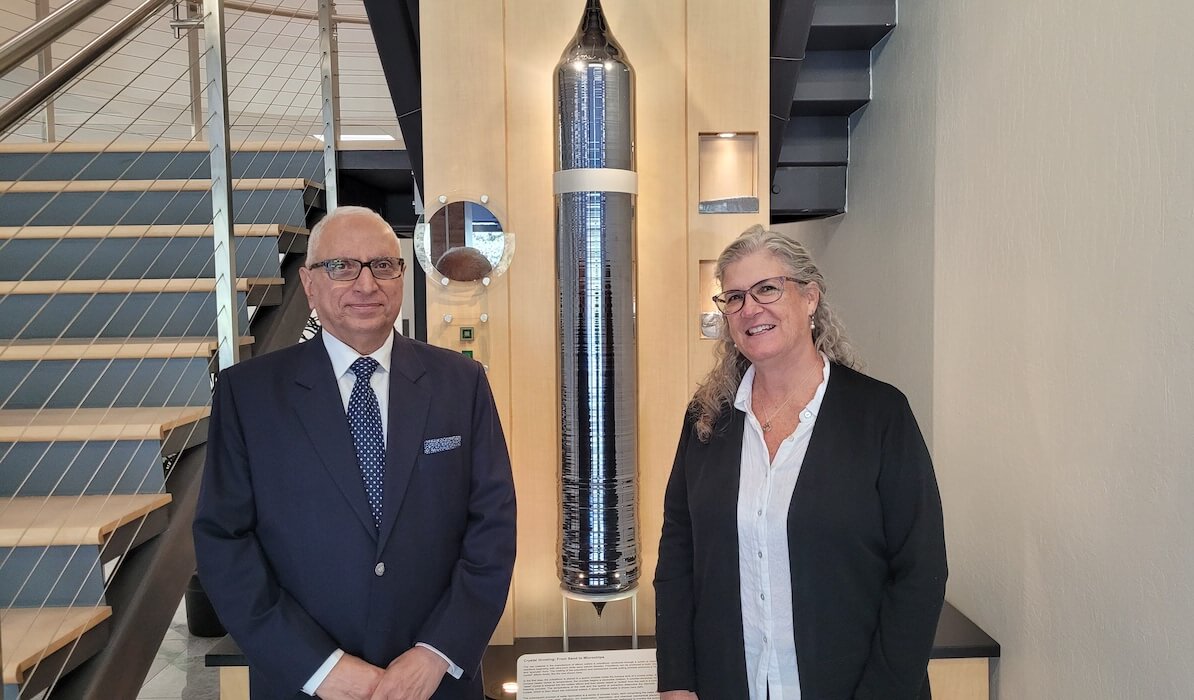A Conversation About Leadership with SEMI CEO Ajit Manocha
For the past few years, we’ve heard semiconductor market analysts prognosticate that based on estimated demand, semiconductors have the potential to become a $1Trillion industry in the next 7-10 years. This number is based on analysts’ projections of driving markets including artificial intelligence (AI), electric and autonomous vehicles, 5G and 6G networks, high-performance computing, data centers… the list goes on.
The operative word here is “potential.” Roadblocks like supply chain issues, sustainability goals, geopolitical issues, a global talent shortage, and an economic downturn are all impacting how and when we actually reach this goal. Make no mistake, the demand is there. But achieving it sustainably is going to take collaboration and strong leadership. As SEMI President and CEO, Ajit Manocha has been known to say, “No single CEO, no single company, no single country, can achieve everything we need to do to meet our 2030 goals of $1T and Net Zero.”
After interviewing Ajit for the 3D InCites Podcast and hearing him speak so passionately about the industry that he has served for over 40 years, I decided his personal journey was the story we wanted for the cover of the 2024 Yearbook.
So we sat down and started talking. With little prompting, Ajit shared anecdotes of his journey as a student of leadership, and how he implemented all the lessons he learned in each role he held as he climbed the executive ladder. In this article, he shares what it means to be a leader in the semiconductor industry over the past four decades, the lessons he’s learned, and how one thing led to another to bring him to the pinnacle of his career as the head of the world’s largest semiconductor association.
Choosing the Semiconductor Path
To hear Ajit tell it, it seems like the semiconductor industry chose him, and not the other way around. In India, where he grew up, there were two professional paths that parents encouraged their children to pursue above all others: medicine and engineering. “And that’s still the case today,” he noted. Luckily, he was fascinated by science, technology, engineering, and math (STEM). “I was pretty strong in math, chemistry, and physics.”
Majoring in Chemistry, Ajit completed his undergraduate and graduate studies in India. He moved to the U.S. for a research position at Bell Labs, which was at the time (1980s) the most prestigious research institute in the world. As his first job out of university, Ajit says it was like hitting the jackpot. “I was told that my job is to serve mankind in the semiconductor technology arena,” he recalls. And that’s a job he took very, very seriously throughout his career.

At Bell Labs, he learned how semiconductors work, and how to use his chemistry degree to solve some critical challenges. He developed and patented a process using Nitrogen trifluoride (NF3) to replace fluorocarbon-based chemistry which solved a major problem with polymer deposition on wafers. “That gave me a lot of motivation,” he said. “When I filed that first patent, it was like ‘Wow! I’m an inventor now!’ And it was a big deal.” He remembers the thrill of filing those early patents, and the accolades that came along with it – coffee with the boss, a patent book, your name in the newspaper. He was hooked.
In those days, the key performance indicator (KPI) of Bell Labs was to produce one patent a day. As his patent filings started piling up, Ajit was promoted from a member of the technical staff in R&D to supervisor – which is the equivalent of VP of R&D today. He was now in charge of a research team, and his goal for that team was to set records for patent filings.
Early Lessons in Leadership
A researcher at heart, Ajit pays attention to all the variables and makes assessments and decisions about what to do next. He is not so arrogant to think he knows everything about being a leader, just because he was promoted.
In fact, one of the earliest and most memorable lessons he learned was from, the head of HR at Bell Labs. He came to her for advice after discovering that despite his team’s great success in filing more patents than any other department, they were not happy. When he asked one of them why, he told him, “These are all your ideas, not my ideas.” When other members of the team confirmed this sentiment, Ajit was troubled. The HR lead’s advice? Stop being a micromanager and give them a chance to work on their ideas.
He listened to her, and productivity and patent applications increased even more. This was a pivotal moment for Ajit when he learned the difference between being a boss and being a leader. And it guides him today.
Climbing the Ladder of Leadership
Fixing complex problems is Ajit’s superpower, and it’s taken him around the world and up the ladder of success at some of the semiconductor industry’s most renowned semiconductor companies.
When there was a disconnect between the lab and manufacturing when implementing processes developed at Bell Labs, Ajit requested a rotation in manufacturing to understand the other side of the story. So, they sent him to fix issues at the Madrid fab. There, he navigated cultural differences to better understand the Spanish work/life balance. This was the 90s and work/life balance was not a global initiative like it is today.

“In semiconductor manufacturing, there is no work/life balance, because fabs run 24/7 and customers expect timely delivery,” he explained. Finding that alignment between business culture and the country’s culture was a tightrope walk. Ajit said he wanted to respect their culture but also demanded productivity while they were on the job. He got his message across, because the fab became productive, even though the Spanish and European culture still demands work/life balance. “Instead of giving us more money, give us more days off,” he said. “They want to enjoy life.”
Ajit must have a million stories like this one, as his career path took him from fixing the fab in Madrid to managing the merger of AT&T Microelectronics and NCR microelectronics; advising on, and co-leading the spin-out of Philips Semiconductors (now NXP) from Philips; retiring and serving on multiple boards; coming out of retirement to serve as CEO of GlobalFoundries; and coming out of retirement AGAIN to lead SEMI as the semiconductor industry endeavors to find a sustainable path to $1 Trillion.
Ajit Manocha’s 10 Guiding Principles of Leadership
Through it all, Ajit swears by 10 guiding principles of leadership that his team at Philips Semiconductors presented him while they were setting new records of success during his early years at the company. Garnered from two years of monthly all-hands meetings, these were his pearls of wisdom that they took away from the talks. He was quite touched to learn that they’d been paying such close attention. The goal of these guiding principles is to succeed by making customers even more successful.
- Preach and practice: With the people, for the people, and by the people. Ajit says this is the most important principle and stems from what he learned early in his role as a lab supervisor.
- Think of your job as your own business. You’ll always give more and think differently when you’re running your own business than if you’re working for someone. As president and CEO of SEMI, Ajit has extended this principle to thinking of the entire semiconductor industry as his own business, and it shows.
- If you are not part of the solution, then you are part of the problem. Ajit takes this one even further to say:
- If your people are not part of the solution, then management is part of the problem. He advises managing people, not the issues.
- Change people, or change people, until everyone is aligned to the common goal. Note the underlined emphasis. If people won’t change to align, then they must be replaced with those who are aligned.
- Make yourself redundant because that helps you develop your people. It might make you feel insecure, but in the end, it’s healthier for the organization.
- Market your people’s contributions that lead to customers’ success
- Focus on the success, not just the good results.
- Anticipate and manage the unknown. Anyone can manage what is known to them. Managing the unknown, such as the industry cycles, is very important for good leadership.
- Remember, your future is in your own hands.
Highlights and Key Takeaways
Ajit says that one of the highlights of his career was as CEO of GlobalFoundries, helping to establish a semiconductor ecosystem when GlobalFoundries was just a greenfield fab in Malta, NY. At the time, he was serving on President Obama’s committee for advanced manufacturing, partnership, and communities. He recalls Obama’s visit, when there was no ecosystem, and GlobalFoundries was just a greenfield fab in the boondocks of Malta, New York. He was struggling to find the workforce to fill the fab, and Obama said to him, we’re investing $10 billion, so fix it. GlobalFoundries hired around 350 veterans and trained them to become technicians. And that was the beginning of a program for hiring veterans. Today, at SEMI he’s charged SEMI Foundation with the task of developing a VetWorks Initiative as one lever to address the global semiconductor talent shortage.
These days, Ajit is most passionate about the PFAS issue, which involves “forever” chemicals that are slated to be phased out from use in the coming years. Finding alternatives to replace these pervasive materials is a bigger challenge than the wafer processing issues he dealt with early in his career. To address this, he brought together policymakers from multiple regions to discuss industry issues with top executives at a first-of-its-kind summit held during the International Trade Partners Conference (ITPC) in October.
This event demonstrated Ajit’s recognition of the value of respecting local cultures and keeping close ties with governments to minimize surprises and avoid exploitation. And while the PFAS issue represents a challenge that “no single CEO, no single company, no single country” can address, if anyone can bring them together to make it happen, Ajit can.
By following his own guiding principles, Ajit’s career path has led him around the world and made him a much sought-after consultant, especially when it comes to forming collaborations. He understands the importance of building an ecosystem to support fabs. He realizes the importance of establishing a solid business culture while not disrupting a country’s culture.
Could there be a more qualified individual to lead the industry to sustainably achieving its $1Trillion goal? He’s too humble to admit it. But I’d put my money on him.
This post first appeared as the Cover Story of the 2024 3D InCites Yearbook. Read the issue here.



















